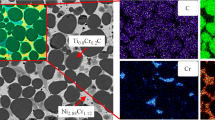The paper examines how the shock sintering temperature and carbon content of the VK25 hardmetal and the process time and discharge energy in the electrospark deposition of the hardmetal onto steel 45 samples influence the mass transfer, thickness, and microhardness of the resultant surface layers. The experiments were performed employing an Elitron-24 unit providing a discharge energy of 0.34–1.1 J. The VK25 hardmetal was produced by shock sintering in the range 1150–1300°C using WC with different carbon contents. For the maximum mass transfer, the hardmetal sintering temperature should be 100–150°C lower than the temperature at which samples with the highest strength were produced. The maximum mass transfer was observed when the hardmetal was depleted of carbon (3.9 instead of estimated 4.59 wt.%). A protective layer 100–200 μm thick, with a hardness of 8.0–13.7 GPa, was produced on the steel samples.











Similar content being viewed by others
References
B.N. Zolotykh and R.R. Melder, Physical Fundamentals of Electrospark Processing [in Russian], Mashinostroenie, Moscow (1977), p. 43.
P.S. Gordienko, A.D. Verkhoturov, and V.A. Dostovalov, “Electrophysical model of electrode erosion in pulsed energy impact,” Elektron. Obrab. Mater., 47, No. 3, 15–27 (2011).
A.E. Gitlevich, P.A. Topala, V.A. Snegirev, and D.A. Ignatkov, “Electrospark erosion of electrodes in pulsed discharges in undervoltage,” Elektron. Obrab. Mater., 24, No. 3, 9–12 (1988).
D.N. Korotaev, V.A. Kim, and E.V. Ivanova, “Effect of electrospark deposition conditions on the composition, distribution, and energy state of the anode mass flow,” Uprochn. Tekhnol. Pokryt., No. 6, 21–25 (2008).
K. Albinski, “Spark erosion stability of working electrodes in electrospark and electric pulsed processing,” Stanki Instrum., No. 7, 11–13 (1994).
L.S. Palatnik, “Phase transformations in electrospark processing of metals and experience in establishing the criterion of observed interactions,” Dokl. Akad. Nauk SSSR, 89, No. 3, 455–458 (1953).
A.E. Gitlevich, V.V. Mikhailov, N.Ya. Parkanskii, and V.M. Revutskii, Elektrospark Alloying of Metal Surfaces, Shtiintsa, Kishinev (1985), p. 196.
A.D. Verkhoturov, A.V. Kozyr, and L.A. Konevtsov, Scientific Fundamentals of the Development and Production of Layered Materials on Hardmetals [in Russian], Dalnauka, Vladivostok (2016), p. 475.
I.I. Safronov, P.A. Topala, and A.S. Gorbunov, Spark Erosion Processes on Electrodes and Microstructural Phase Composition of Doped Layer [in Russian], TEHNICA INFO, Kishinev (2009), p. 473.
Yu.G. Tkachenko, E.P. Ignatenko, and G.A. Bovkun, “Effect of the anode structure on electrospark strengthening with hardmetals,” Elektron. Obrab. Mater., 17, No. 4, 21–24 (1981).
I.M. Mukha, A.D. Verkhoturov, and S.V. Gnedova, “Material of doping electrodes with a hardmetal matrix with boron microadditions,” Elektron. Obrab. Mater., 1, No. 4, 24–27 (1981).
V.I. Tretiakov, Fundamentals of Physical Metallurgy and Technique of Producing Sintered Hardmetals [in Russian], Metallurgiya, Moscow (1976), p. 527.
A. Laptiev, Z. Pakiela, O. Tolochyn, and T. Brynk, “Microstructure and mechanical properties of WC–40 Co composite obtained by impact sintering in solid state,” J. Alloys Compd., 687, 135–142 (2016).
A.V. Laptev, O.I. Tolochin, and M.S. Kovalchenko, “Method of producing ultrafine hardmetals containing a binder,” Ukrainian Patent UA80215, Bulletin No. 13 (2007).
G.S. Upadhyaya, Cemented Tungsten Carbides: Production Properties and Testing, Noyes Publications, Fairfield, New Jersey, USA (1998), p. 420.
A.S. Kurlov and A.I. Gusev, Physics and Chemistry of Tungsten Carbides [in Russian], Fizmatlit, Moscow (2013), p. 272.
O.V. Paustovskii, Yu.G. Tkachenko, and S.M. Kirilenko, “Technology and materials for electrospark strengthening and recovery of machine parts,” in: Issues of Service Life and Operational Safety of Structures, Facilities, and Machines [in Ukrainian], Inst. Elektrozvar. Patona NAN Ukrainy, Kyiv (2006), pp. 553–557.
G.A. Mesiats, “Ecton or electron avalanche from metal,” Usp. Fiz. Nauk, 165, No. 6, 601–626 (1995).
G.A. Bovkun and A.V. Laptev, “Relationship between erosion and mechanical characteristics of fine-grained hard alloy WC–16% Co obtained by solid-phase and liquid-phase consolidation. Part 1. Erosion resistance,” Powder Metall. Met. Ceram., 43, No. 5–6, 265–272 (2004).
G.A. Bovkun and A.V. Laptev, “Relationship between erosion and mechanical characteristics of fine-grained hard alloy WC–16% Co obtained by solid-phase and liquid-phase consolidation. Part. 2. Mass transfer (cathode mass gain and transfer coefficient),” Powder Metall. Met. Ceram., 43, No. 7–8, 68–76 (2004).
V.M. Panashenko, I.A. Podchernyaeva, A.D. Panasyuk, and D.V. Yurechko, “Mass transfer in electrospark deposition in the ceramic—ceramic system,” Elektr. Kont. Elektrodes., Inst. Probl. Materialoved. NAN Ukrainy, Kyiv (2010), pp. 160–171.
Author information
Authors and Affiliations
Corresponding author
Additional information
Translated from Poroshkova Metallurgiya, Vol. 58, Nos. 11–12 (530), pp. 91–104, 2019.
Rights and permissions
About this article
Cite this article
Tkachenko, Y.G., Tolochyn, O.I., Britun, V.F. et al. Effect of Shock Sintering Temperature and Carbon Content of the WC–Co Hardmetal Anode on the Mass Transfer in Electrospark Deposition. Powder Metall Met Ceram 58, 692–702 (2020). https://doi.org/10.1007/s11106-020-00126-9
Received:
Published:
Issue Date:
DOI: https://doi.org/10.1007/s11106-020-00126-9




